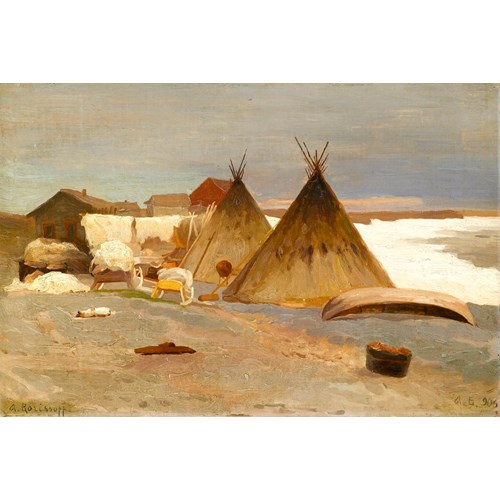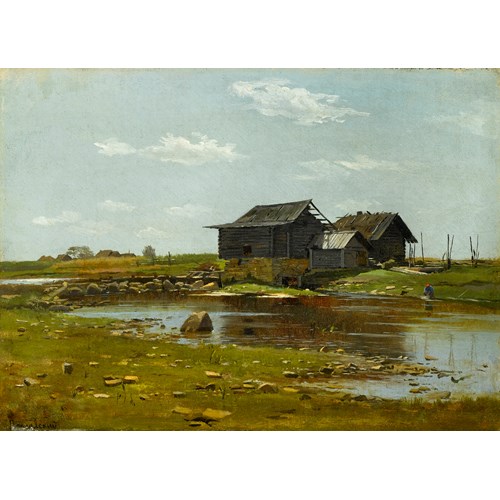Marketplace
Portrait of a Kirghiz
Aleksandr Evgen'evich Yakovlev
Portrait of a Kirghiz
Date 1931
Epoque 20th century
Origine Russia, France
Medium Pastel, Chalk on paper
Dimension 52 x 36.5 cm (20¹/₂ x 14³/₈ inches)
Aleksandr Yakovlev’s sanguine and pastel drawings, of which A Desert Fort is another example, are particularly refined works. In Portrait of a Kirghiz Yakovlev almost exclusively uses red chalk to depict the Kirghiz’s face; to this he then lightly adds touches of black chalk to create the wispy tufts of beard. Remarkably, through the mere use of darker shading, Yakovlev manages to create lifelike and almost tangible features. The deep channels of the old man’s forehead, his chapped lips, and the folds of skin under his eyes, bring this intriguing character to life.
In the summer of 1917, Yakovlev received a scholarship to study in the Far East, remaining there until 1919. During his sojourn abroad, the Russian Revolution broke out and on his return Yakovlev resettled in Paris. He became a member of the Russian émigré community and quickly established himself as a distinguished travelling artist. This reputation resulted in two considerable commissions by the motor company, Citroën. Appointed Artistic Adviser, Yakovlev joined Citroën on two caravan journeys led by Georges-Marie Haardt (1884-1932). During the first of these, from 1924 to 1925, Yakovlev took part in an expedition to the Sahara desert and Equatorial Africa, named the ‘Croisière Noire’. His African paintings were a big success and as a result Yakovlev was awarded the Legion of Honour by the French government in 1926.
The second expedition, across Asia, the ‘Croisière Jaune’, was between 1931 and 1932. This expedition through treacherous conditions, saw Yakovlev travel to Syria, Iran, Afghanistan, Mongolia and China, where he made numerous drawings and created a number of paintings portraying the indigenous people and the surrounding landscape. Portrait of a Kirghiz was one such work as was the comparable Sharafat, Gulmit Juillet 1931, (Private Collection) drawn a couple of months before. Both works are executed in Yakovlev’s characteristic red chalk which picks out the deep furrows of the subjects’ aged worn face. Neither figure meets the viewer’s eye, but instead they look contemplatively out into space. Each drawing is a beautifully rendered, highly individualised portrait which reveals not only Yakovlev’s masterly skill, but also his intense ethnographic interest. Critics praised the series and Yakovlev was hailed as ‘the most accomplished and the most astonishing type, of those very rare ones for whom Fortune is waiting in the heart of the strangest regions with a store of unknown treasures.’
Yakovlev was born in St. Petersburg, the son of a naval officer, and studied at the Imperial Academy of Arts from 1905-1913. In 1912 he joined Mir iskusstva, the Russian magazine and art movement, which was so influential throughout Europe. He spent much of his life travelling, depicting the variety of cultures he encountered, and a mature work such as Portrait of a Khirgiz reflects the best of his art.
In the summer of 1917, Yakovlev received a scholarship to study in the Far East, remaining there until 1919. During his sojourn abroad, the Russian Revolution broke out and on his return Yakovlev resettled in Paris. He became a member of the Russian émigré community and quickly established himself as a distinguished travelling artist. This reputation resulted in two considerable commissions by the motor company, Citroën. Appointed Artistic Adviser, Yakovlev joined Citroën on two caravan journeys led by Georges-Marie Haardt (1884-1932). During the first of these, from 1924 to 1925, Yakovlev took part in an expedition to the Sahara desert and Equatorial Africa, named the ‘Croisière Noire’. His African paintings were a big success and as a result Yakovlev was awarded the Legion of Honour by the French government in 1926.
The second expedition, across Asia, the ‘Croisière Jaune’, was between 1931 and 1932. This expedition through treacherous conditions, saw Yakovlev travel to Syria, Iran, Afghanistan, Mongolia and China, where he made numerous drawings and created a number of paintings portraying the indigenous people and the surrounding landscape. Portrait of a Kirghiz was one such work as was the comparable Sharafat, Gulmit Juillet 1931, (Private Collection) drawn a couple of months before. Both works are executed in Yakovlev’s characteristic red chalk which picks out the deep furrows of the subjects’ aged worn face. Neither figure meets the viewer’s eye, but instead they look contemplatively out into space. Each drawing is a beautifully rendered, highly individualised portrait which reveals not only Yakovlev’s masterly skill, but also his intense ethnographic interest. Critics praised the series and Yakovlev was hailed as ‘the most accomplished and the most astonishing type, of those very rare ones for whom Fortune is waiting in the heart of the strangest regions with a store of unknown treasures.’
Yakovlev was born in St. Petersburg, the son of a naval officer, and studied at the Imperial Academy of Arts from 1905-1913. In 1912 he joined Mir iskusstva, the Russian magazine and art movement, which was so influential throughout Europe. He spent much of his life travelling, depicting the variety of cultures he encountered, and a mature work such as Portrait of a Khirgiz reflects the best of his art.
Date: 1931
Epoque: 20th century
Origine: Russia, France
Medium: Pastel, Chalk on paper
Signature: Inscribed, signed and dated 'Merghen/ Kirghiz/ Reyik Karane/ A Iacovlev/ 4 Sept. 1931' (lower right).
Dimension: 52 x 36.5 cm (20¹/₂ x 14³/₈ inches)
Plus d'œuvres d'art de la Galerie




, in a Green Dress and Pearls, Standing at a Draped _T638990626119457264.jpg?width=500&height=500&mode=pad&scale=both&qlt=90&format=jpg)




